Since the seventies of the last century, the most common computer icons have come a long and thorny path. This article is an attempt to collect a collection of icons illustrating the development of computer iconography. And although in the period from 1981 to 2010, there were many different operating systems with a graphical interface, only the most significant ones that had the greatest impact on modern icon design were selected.
Year 1981. Xerox 8010 Star - the first computer for ordinary customers with a graphical user interface
In 1973, Xerox Alto became the first computer in the world with a graphical user interface (GUI). The design of the icons used the “office” metaphor, by the way, also for the first time in the world. Alto was created for scientific research and therefore did not hit the wide market. In total, about two thousand such machines were produced and, later, the success of Xerox Alto gave impetus and inspired Apple to create the Lisa computer (in 1983). In 1981, Xerox Star was released, developing Alto ideas and including all the innovations and discoveries of its ancestor. Xerox icons demonstrate the principle of human interaction with the computer interface through familiar things. Look, calculator icons, documents, folders and baskets have not changed at all over the past thirty years.

1981 - Xerox 8010 Star
Year 1983. Apple Lisa - popularization of the graphical interface
Apple began to develop the Lisa computer back in 1978, under the strong influence of the early Xerox computers. Hoping to occupy a niche in the personal computer market, Apple adopted the “office” metaphor to make it easy for newcomers to communicate with a computer. For that time, Lisa had an extremely advanced graphic interface: she had “Desktop accessories” (and, in fact, widgets), drop-down menus and directories in the form of folders. As you can see, the Lisa icons differ little from the Xerox computer icons, with the exception of the size and single-pixel stroke, as well as using the computer's icon for the settings panel (it is now customary to use a gear for this purpose).

1983 - Lisa Office System 1
Year 1984. Apple Macintosh 1.0 - Icons Created by the Artist
A year after the release of Lisa, Apple Macintosh 1.0 was born. From now on, you can copy files using the drag'n'drop method, move windows, and in addition, new stunning icons have appeared. This time, the creation of icons was managed by the now legendary Susan Kare. Susan has created many icons for Apple, including icons for the MacPaint interface (Figure 2). Car's philosophy is simple - “I think that good icons are much closer to road signs than to ordinary drawings, and, ideally, should be as simple, concise and memorable as possible. I try to make the icons as clear and simple as possible, even though much more graphic capabilities have appeared in current computers. ” This philosophy was the basis for the commercial success of Apple in those years.

1984 - Macintosh System 1.0 (Fig. 1)
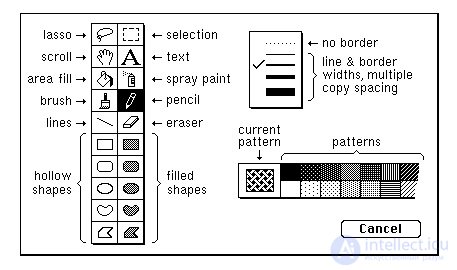
1984 - Macintosh System 1.0 (Fig. 2)
Year 1985. Atari TOS - isometric icons
It is important to note that in those years, not only Apple computers had a graphical interface. Atari ST had its own operating system TOS, which had a minimalistic interface that uses the same desktop metaphor that had become the computer standard by then. By the way, some of the TOS icons were drawn isometric.

1985 - Atari TOS Version 1.0
Year 1985. Amiga Workbench - four-color icons
The Amiga Workbench was created for the Amiga 500 personal computer. And, despite the crudely drawn icons, it was extremely progressive for that time. It was possible to change the appearance of the cursor, the icons were four-color, and also had the ability to visually change the state. Amiga changed the philosophy of the "desktop" and used in their environment workplace with drawers instead of folder icons.

1985 - Amiga Workbench 1.0
Year 1985. Windows 1.0x - the first Microsoft OS with a graphical interface
In 1985, Microsoft finally managed to release its first graphical user interface. The icons looked as rough as the Amiga, and they were also black and white. Interesting, but the first Windows Painter icons directly borrow some of the characters from MacPaint, especially the Spray Painter icon.

1985 - Windows 1.0x
Year 1986. GEOS for Commodore 64 - Alternative OS
GEOS for Commodore 64 should be added to the list, since at the time this graphical interface was the second most popular after Macintosh 1.0 (by the number of units sold). The icons were much more expressive than those of Microsoft, but they professed the Macintosh philosophy - the philosophy of simple metaphors.

1986 - Commodore C64 GEOS
Year 1991. Macintosh System 7 - the first color Mac OS
In System 7, icons make friends with color. In addition, they are slightly grown for more "clickability".
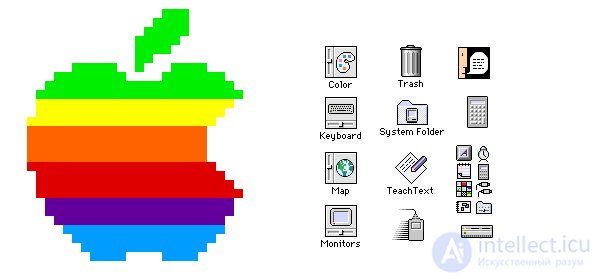
1991 - Macintosh System 7
Year 1992. Windows 3.1 - New Design Icons!
In Windows 3.0 (1990), Microsoft used icons that were already familiar to us from Susan Ker (who had previously created icons for Macintosh 1.0). For Windows 3.1, Susan has even more ennobled the colors and appearance of the icons. In addition, Windows 3.1 was the first Microsoft platform with pre-installed True Type fonts.
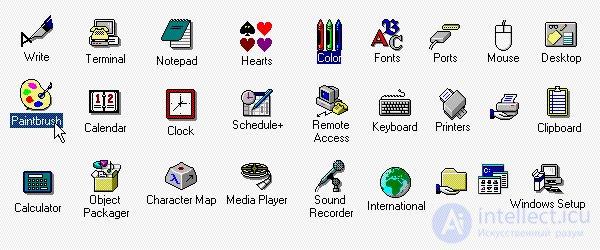
1990 - Windows 3
Year 1995. Windows 95 - Start Button
Windows 95 allowed to make icons more colorful. In addition, several more isometric objects appeared. The design of the interface of Windows 95 has been radically reworked, it included some of the elements that live in Windows to this day. This is the taskbar, menu, and the talk of the start button.
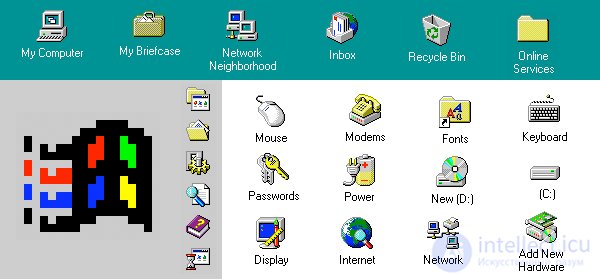
1995 - Windows 95
Year 1997. Macintosh OS 8 - Bright Icons
On Mac OS 8, the icons look much brighter, with a clearly visible direction of the light source. In Macintosh, they began to introduce an isometric style with a shadow effect.

1997 - Macintosh OS 8
2001 Mac OS X v10.0 - Mac Style
The release of Mac OS X was marked by the appearance of shiny, plastic-jelly icons that looked just perfect. The icons of OS X have become just a huge jerk forward compared to the icons of OS 9, released two years earlier (its icons looked almost the same as the icons of OS 8). Probably due to the appearance of the dock, all the icons were drawn as if the source of light was either directly in front of them or slightly above them. Created as an integral part of the new graphic theme Aqua, the icons had complex reflections, highlights and textures. I am sure that it was Aqua that set the tone by which the current computer iconography is so diverse and interesting.

2001 - Mac OS X v10.0
Year 2001. Windows XP - bright calm icons
In 2001, Microsoft introduced a new operating system to the public. Using a rich color palette, the icons, however, look calm. There is one light source, as well as translucent falling shadows. Isometrics continue to be used in style.
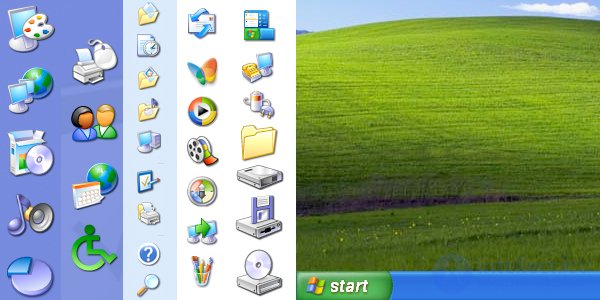
2001 - Windows XP
Year 2007. Mac OS X Leopard - dock with reflection
Mac threw away the stripes and gave birth to a 3D-style dock, reflecting the icons located on it. The use of chrome, glass and reflections is more popular than ever. The icons themselves have not undergone any significant changes since OS X.
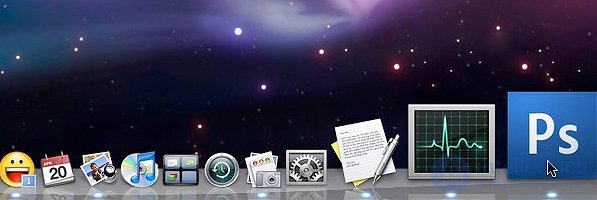
2007 - Mac OS X Leopard
Year 2009. Windows 7 — quiet with reflections
Windows 7 icons are fundamentally different from Windows XP icons and inherit Vista icons. The main difference is that Windows 7 and Vista icons look left, not right, like Windows XP icons. In the seven, the icons are even calmer, softer, although with a clear presence of the reflection effect.
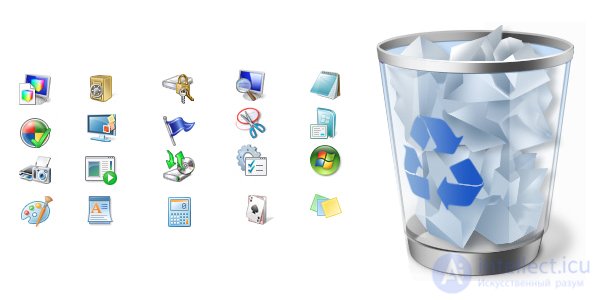
2009 - Windows 7
In the early 2000s, the first realistic icons began to appear. For the first time - in Mac OS X. The first realistic Windows icons appeared in 2001 in Windows XP. They became bigger and more detailed in Windows Vista 2007. Infographic authors call this the "rococo style." That same year, Apple revealed the first iPhone with iPhone OS 1.0. Icons and the interface there imitated real surfaces (skeuomorphism). A year later, Google released Android, the interface in which is designed on the same principle.
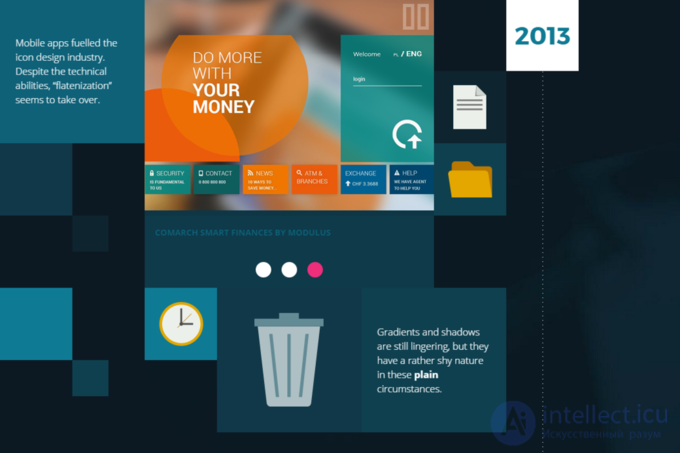
fbvkpn
The beginning of the 2010s in infographics is called “the end of an era of realism.” During this period, designers begin to return to the roots and original icons. Windows Phone 7 2010 with a completely “flat” interface in infographics is called a “revolutionary” idea. After that, web applications began to adopt the style of mobile device icons.
In the work of Futuramo and Modulus, the material design of Google, modern versions of OS X, iOS 7 and later, as well as icons from other operating systems (Firefox OS, Fire OS and Ubuntu) are missing.
















Comments
To leave a comment
design software UI and Web design
Terms: design software UI and Web design